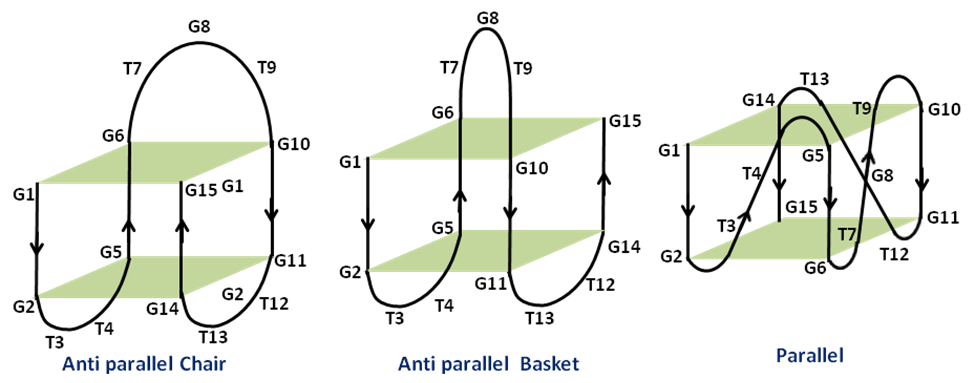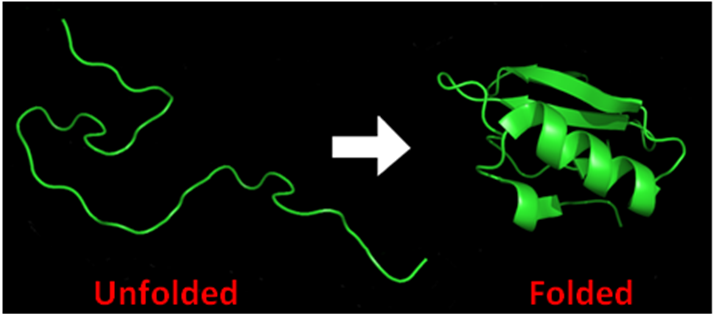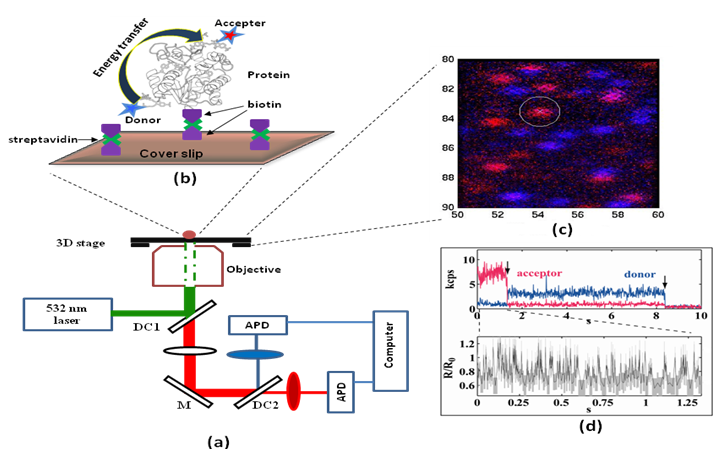Research
1. Conformational fluctuation of aptamer for biomolecular sensor
 Thrombin binding aptamer in different conformation in different chemical environment
Thrombin binding aptamer in different conformation in different chemical environmentAptamers have emerged as a new class of molecular sensors that find a wide range of applications including therapeutics, diagnosis, and small-molecule sensing because of their structural flexibility. The very unique and important properties of this class of molecules over other biomolecules are to bind specifically with ligands with high affinity. However the binding affinity of these flexible molecules depends on their structural fold and local chemical environment. The folding dynamics is expected to play a very important role as it changes the accessibility and the nature of the chemically reactive sites. Moreover, due to their distinctive properties, such as high association constant with target, easy production, easy labeling with signal moieties, cost-effectiveness and stability during long-time storage, aptamers have attracted the attention of many research groups for fundamental studies and as well as for practical applications in therapeutic and in novel drug delivery. In this research program we study conformational dynamics of DNA aptamer in various local chemical environment in the presence or absence of ligand proteins by simultaneously measuring multiple fluorescence properties of the probe fluorophores in single macromolecules. The main aim is to understand the roles of aptamer conformation fluctuations in rapid screening in biosensing applications and in therapeutics.
Position Open: We are always looking for self motivated hard working individuals who always enjoys scientific research chalanges. Please contact the PI directly by sending mail.
2. Aptamer conjugated Gold nanoparticle for Cancer treatment
Aptamer-conjugated FRET nano-particles (NPs) are highly promising for potential applications in the sensitive monitoring of multiple cancer cells for biomedical research and medical diagnostics. How to recognize multiple trace biomarkers or cancer cells from complex living samples is a critical issue for the early diagnosis of cancer. Simultaneous monitoring of different types of cancer cells in a single assay would require the recognition of specific receptors on the cell membrane surface. However, it is precisely the lack of specific molecular probes for cancer biomarkers that, in part, hinders greater progress in this area. Address this limitation, aptamers, which are single-stranded oligonucleotides, represent an attractive alternative to antibodies as specific ligands to recognize multiple trace biomarkers or cancer cells from complex living samples. In this project we also try to understand the selection of effective therapeutic pathways and improve clinical outcomes, sensitive and simultaneous diagnosis of multiple trace biomarkers or cancer cells from complex living samples which is particularly critical in the early stages of tumor development.
3. Protein folding dynamics single molecule Forster Resonance Energy transfer

Understanding the structural landscape of proteins is both a fundamental research goal and prerequisite for therapeutic and in novel drug discovery as it is directly related to protein functions. Whether acting alone or working together, proteins are capable of performing remarkably diverse tasks with exquisite sophistications that rival the most complicated mechanical contrivances. Many of the important tasks of proteins utilize thermally driven, large amplitude conformational transitions which play an important role in their functions because they change the accessibility and the nature of chemically reactive sites. However, these large amplitude dynamical motions cannot be readily captured by static crystallographic structures or NMR. Our research group will focus mainly the protein folding dynamics using single molecule Forster Resonance Energy transfer to understand the relationship between conformational fluctuations and their functions in proteins. Our approach combines unique capabilities to measure the properties each detected fluorescence photons with rigorous new data analysis methods that will extract the maximum information about the macromolecular fluctuations from experimental record of photons.

Schematics of single molecule Forster Resonance Energy Transfer (smFRET). Home-built confocal instrumental scheme (Fig. a), Carotoons of donor and accepter labeled protein molecules attached to the quartz coverslip (Fig. b), a typical raster scanning image (Fig. c) of the labeled single protein molecule, a typical trajectories of the marked fluorophore Fig. d (top: bleaching times of the donor and accepter; bottom: distance distribution)
4. Organic polymers solar cells: The challenges and improvement
An alternative source of the renewable energy resource, globally, is to produce efficient solar energy from sunlight. Though organic polymer solar cells has decreases the cost over inorganic semiconductor solar cell but still a major challenge is to produce efficient organic polymer molecules for producing efficient low cost solar energy. The main disadvantages associated with organic solar cells, which is formed by the formation of localized electron- hole pair i.e Frenkel type exciton, are low efficiency, low stability and low strength compared to inorganic photovoltaic cells. The exciton binding energy is typically very large in organic solar cells, which leads a critical component in the architectures of organic solar cells is the design of the heterojunction between an electron-donor material and an electron acceptor material. We will focus on the detail optical processes and advantages of organic solar cells and the possibility of designing followed by synthesis of suitable polymerizable monomers which could produce low band gap polymers or copolymers through the incorporation of proper donor-accepter units.